Last updated on 4/7/24
View My Guestbook
Sign My Guestbook

Last updated on 4/7/24
Site established on 3/22/01
|
|
D Troop, 3rd Squadron, 17th Cavalry Regiment
|
Click here to visit Delta Troop 3/17 Air cav, 3rd Platoon, Vietnam 1969 to 1970
| ||
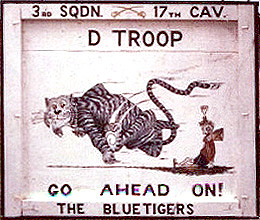 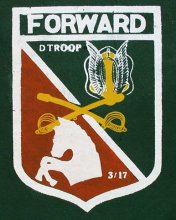
This sign on the left stood outside the troop hooches at Dian. Image courtesy of Blue Tiger web site via Bill Nevius. Delta Troop was a cavalry reconnaissance troop that served in Vietnam from October 1967 to April 1972. Our parent organization, the 3rd Squadron/17th Air Cavalry, was an independent air cavalry squadron. The squadron, and even its component troops and platoons, served with many different combat brigades and divisions on temporary assignment. The squadron was the reconnaissance arm, when it was needed, of the corps-level II Field Force, Vietnam from December 1967 to May 1971. II Field Force, Vietnam teamed the squadron with II FFV's ranger company (until it was disbanded in April 1970), giving II FFV its own reconnaissance and intelligence capability anywhere in III Corps Tactical Zone. Delta Troop supplied mounted cavalry reconnaissance and an aero-rifle platoon reaction force to the effort throughout the period, and added long range reconnaissance after April 1970. The 3/17th Air Cavalry most closely matches the more widely documented 1/9th Air Cavalry of the 1st Cavalry Division in composition and structure. Each squadron had three air cavalry troops, one ground cavalry troop, and an assigned ranger company. The main distinction was that the 1/9th Air Cavalry provided reconnaissance and intelligence to the 1st Cavalry Division, while the 3/17th Air Cavalry provided it directly to the next level up in the military hierarchy, II Field Force, Vietnam. Delta Troop and the 3/17th Air Cavalry's independence gave commanders in III Corps Tactical Zone firepower and mobility on a moment's notice. However, the short-term assignments from II FFV to combat brigades or divisions condemn Delta Troop and the other troops of the 3/17th Air Cavalry to be wanderers through the history of American forces in Vietnam. Army historians, assigned to divisions during the war, spot a 3/17th troop or a platoon here and there now and then, but it is impossible to find coherent records of Delta Troop's activities over time. |
||
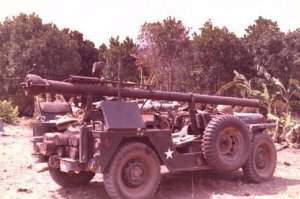
The 106 mm recoilless rifle is a pretty distinctive "artifact" of those of us who didn't drive helicopters in the air cav in the nam. Image courtesy of Jerry Smith and the Blue Tiger web site |
||
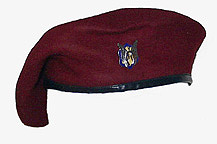
The maroon beret was authorized for D 3/17 in 1967, as the unit shipped to Vietnam, and was reauthorized in 1970. Some of the troopers wore a tab over the 17th Cav unit crest on their berets. I believe they read "recon". The only beret decoration authorized was the 17th Cav crest.
Images and information courtesy of Bill Nevius The Story of Delta Troop's Maroon BeretAlthough the 82nd Airborne wears the maroon beret today, Delta Troop, 3/17th Air Cavalry wore the maroon beret throughout the Vietnam War. The Secretary of the Army authorized Delta Troop's maroon beret in September 1967 at Fort Knox, just before the troop shipped to Vietnam. With the recent controversy over the adoption of black berets by all Army personnel in 2001, some interesting facts on the Army's authorization for beret wear have come to light. It appears that actual authorization of the wear of a beret was very limited during Vietnam. Beyond Delta Troop's authorization to wear a maroon beret, only Special Forces and a few armored and armored cavalry units had the Army's blessing to wear a beret:
The 3/17th Air Cavalrymen have always had a penchant for distinctive headgear. In fact, the 3/17th Air Cavalry is responsible for starting the Stetson Cav hat tradition among Air Cavalry units. In a published history of the Air Cavalry hat ("The Stetson Cavalry Hat"), C. Jenkins points out the Stetson tradition of the Vietnam War originated with 3/17th Air Cavalry at Ft. Benning in 1964.
Delta Troop carried distinctive headgear in the Air Cavalry a step further. Stetsons were nice, but Delta Troop was different from the other troops of the 3/17th. While most of the 3/17th troops trained in 1967 to bring helicopters to combat in Vietnam, Delta Troop trained in Ranger and Special Forces camps for the ground war. The troop trained at the Ranger camp in Dahlonega, GA, and with the 19th Special Forces Group in West Virginia.
John Dungan, one of the original Blue Tigers from 1967, remembers the specific events in the United States that led to Delta Troop being authorized its red beret:
Delta Troop shipped to Vietnam wearing the maroon beret, and wore it throughout the war. Orders reauthorizing the unit's distinctive cover were issued in 1970 in Vietnam. It was reported in the squadron's newpaper that:
The Blue Tigers were always proud of their distinctive maroon berets. On the rare occasions when the troop's platoons were brought together for a stand-down and a party in Vietnam, the Blue Tigers recognized distinguished guests with the honorary award of the Red Beret: 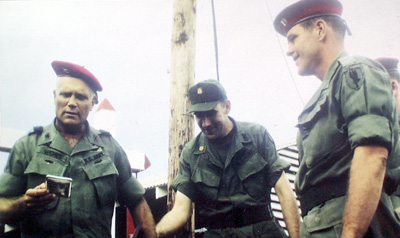
After the Cambodian invasion, Col. John C. Hughes (Corn Cob 6), CO, 12th CAG, brought a congratulatory cake to the Blue Tigers at FB Rob. He was presented a Blue Tiger red beret (seen here on his head about 45 degrees clockwise from correct) by CPT Bryner, Blue Tiger 6, at the field party.
It is not clear exactly when the Blue Tigers of Delta Troop retired the maroon beret after the troop's service ended in Vietnam in 1972. When the 3/17th Cavalry was reactivated in the mid-1980's, the ground cavalrymen of the squadron became the Apaches of A Troop, 3/17th, and they donned the Stetson Cavalry hat that the entire squadron wears today. |
||
All images remain the personal property of this site and the contributor of the photo. You may download them for your personal use but they may not be published or used on any other site without written permission from the webmaster and the contributor.
